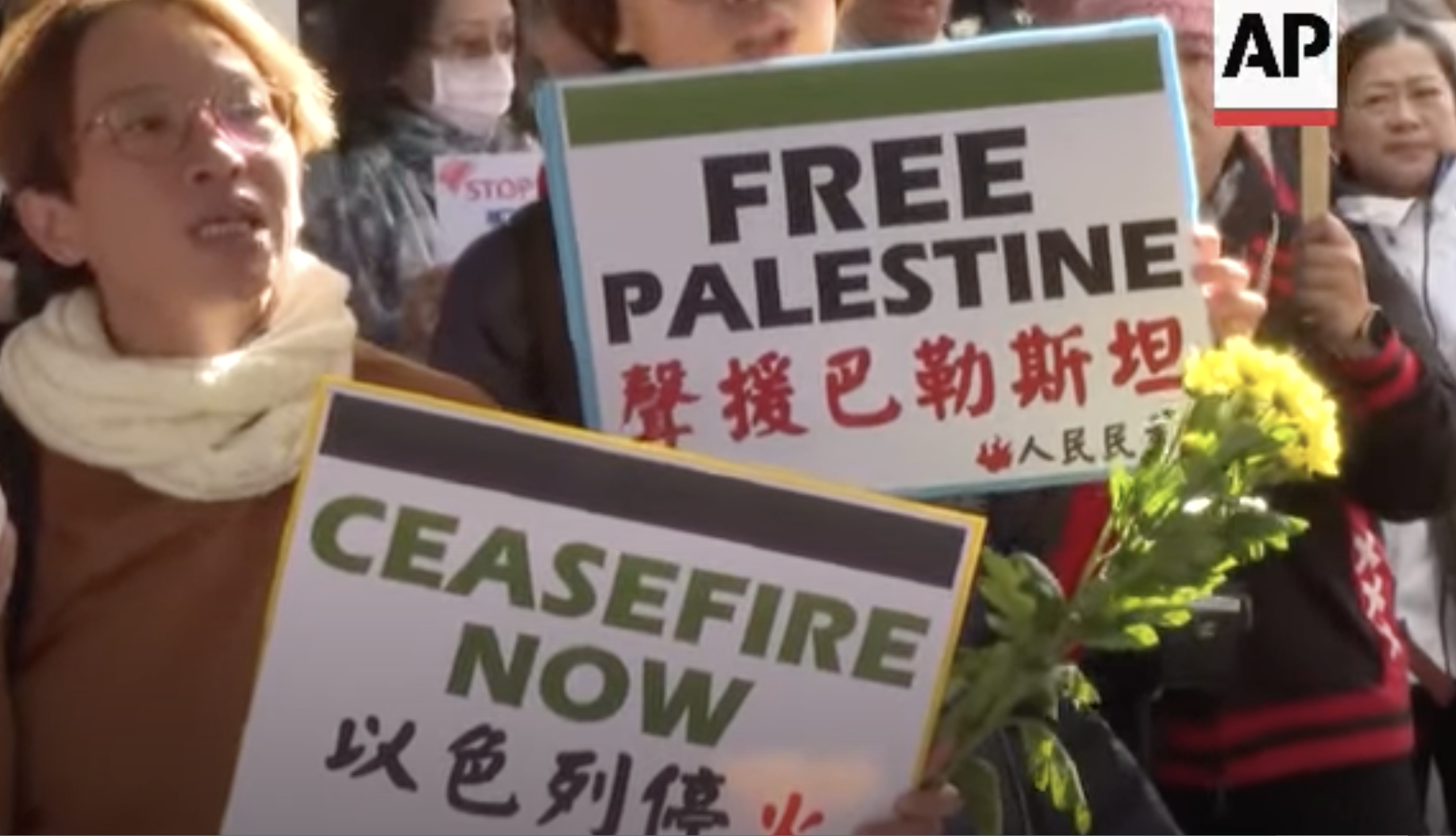
Female members of the Democratic Youth League of Japan carrying wooden staves. Image from Twitter user @oldpicture1900.
Twitter user @oldpicture1900 posts photos that offer a fascinating and often nostalgic glimpse of Japan in the early and mid-20 century.
The account describes itself as “retro photos of Japan, from before until after World War II” (戦前~戦後のレトロ写真). The photos do not appear in any particular chronological order, and are accompanied by a short description.
The Showa Period, a slice of Japanese history that lasted from 1926 until 1989, was a time that saw great turmoil and change in Japan, from participation in a disastrous war that led to utter ruin and defeat, and then on to a miraculous recovery that experienced its own social upheaval.
1971年(昭和46年)。以前も違うのを貼りましたが、三菱重工の反戦一株株主たちです。ベ平連メンバーの一部からなり、株主総会にも参加しました。ソニーが南ベトナムに進出すると発表したときは「日本の再侵略を許すな」と抗議デモもしています pic.twitter.com/sbYKTNc6fI
— 戦前~戦後のレトロ写真 (@oldpicture1900) April 21, 2016
(1971) Shareholders protesting against Mitsubishi arms production. Members the Citizens League for Peach in Vietnam purchase shares and join the annual shareholders meeting. When it was learned that Sony would launch production in South Vietnam, there were also demonstrations organized with the rallying cry, “We will never allow Japan to become an aggressor ever again!”
Many of the wartime photos featured on the Twitter account show what life was like for soldiers in all kinds of situations.
1941年(昭和16年)。中国との闘いの中、傷病兵の中には戦争で精神を病んだ人たちもいました。彼等は一般傷病兵とは違う施設で療養していましたが、国防婦人会は陸軍と交渉し許可を得、リフレッシュさせようと奈良公園に一緒に行きました。 pic.twitter.com/dJHQq604iD
— 戦前~戦後のレトロ写真 (@oldpicture1900) April 22, 2016
(1941) During the war with China, among the sick and injured were those who suffered from psychological trauma. While these troops were treated in separated facilities than the regular wounded, they were still permitted to be visited by the army's female support workers (Kokuhofujin, members of an all-women professional organization devoted to providing emotional and practical support to troops, including returning their cremated remains to family members back in Japan). Here these troops and female support staff are enjoying a day out together in a park in Nara.
This period of Japanese history was not always dominated by war, and the photos feature a look back at celebrities who once dominated pop culture.
次は山路ふみ子さん(1912-2004)です。こちらは正統派和風美人です。人気女優となった後、実業家・社会事業家へ転身。「山路ふみ子映画賞」は今も権威ある賞です。3枚目の右は桂珠子さん、4枚目の左は東海林太郎さんです。 pic.twitter.com/P1hZPLiF2G
— 戦前~戦後のレトロ写真 (@oldpicture1900) May 2, 2016
Yamaji Fumiko (1912-2004), the epitome of traditional Japanese beauty. After becoming a popular actress, she turned to a career in business. The Yamaji Fumiko Prize is named in her honor. Also appearing in this photo are the actress Katsura Tamako (standing on the right in the third image in this set) and the folk singer Shoji Taro (standing on the left in the third image).
Some of the photos go far back before the war, showing how Japanese children lived at the turn of the century.
大正の中ごろ。衣装の切れっ端で遊ぶ子供たち。ゴム飛びの原型でしょうか。 pic.twitter.com/wsuC300V0S
— 戦前~戦後のレトロ写真 (@oldpicture1900) May 2, 2016
Sometime in the Taisho Era (1912-1926). Children dressed in hand-made clothes play “Chinese jump rope.”
Japanese school life is also represented.
1935年(昭和10年)。おそらく旧制の高知高校だと思います。この画像に限らず、当時の旧制高校は長髪の学生さんがかなりいます。 pic.twitter.com/lpGLgg8DcG
— 戦前~戦後のレトロ写真 (@oldpicture1900) May 2, 2016
(1935) Probably students enrolled at a Normal School (high school). As you can see, there are a number of students sporting grown-out hair (rather than shaved heads or crew cuts), typical of Normal School students at this time.
Many of the photos are nostalgic.
1959年(昭和34年)ごろ。紙芝居をやっています。ちょっとかわいそうですがいちばん左の女の子は飴が買えずチラチラと振り返って見ています。 pic.twitter.com/GTCuoaRG7N
— 戦前~戦後のレトロ写真 (@oldpicture1900) May 2, 2016
(Around 1959) A traveling Kamishibai entertainer performs for children. The girl at left likely cannot afford to pay to watch and so sneaks a peek at the show.
While many photos curated by the account remind us of how turbulent Japan's postwar society could be.
1969年(昭和44年)。1月。民青と言う組織の女子大生達です。角材を持っていますね。場所は東大のようです。 pic.twitter.com/oAHci6wYxV
— 戦前~戦後のレトロ写真 (@oldpicture1900) April 30, 2016
(January 1969) Female members of the Democratic Youth League of Japan carrying wooden staves. It's likely they are at student protests at Tokyo University in 1969.
1958年(昭和33年)。日教組が「勤務評定」導入に反発し、大規模な闘争集会を開きます。その集会の様子を塀の外から見る子供たち。 pic.twitter.com/E4qkinrYAC
— 戦前~戦後のレトロ写真 (@oldpicture1900) April 26, 2016
(1958) Children peer over a fence at teachers engaging in large-scale protests against changes to working conditions.
The Twitter account pays special attention to documenting the lives of women in Japan at mid-century.
1943年(昭和18年)。大阪の天下茶屋女性青年団です。戦死者の方々の英霊を弔っています(左)。それはそれとして、灯火管制のどさくさにまぎれ、団長が内緒で彼女達に特別に晴れ着と化粧を許したときの写真です(右)。 pic.twitter.com/nfjS9Ct51H
— 戦前~戦後のレトロ写真 (@oldpicture1900) April 25, 2016
(1943) A female youth organization meets in Tengachaya, Osaka. (Left) The young women are giving their condolences to the war dead. Taking advantage of the confusion of a wartime blackout, the leader of the group has allowed the young women to put on makeup and more attractive clothes [both forbidden under Japan's strict wartime rules for public morals] to pose for a photograph.
There are some truly amazing finds among the daily posts made on this Twitter account
1929年(昭和4年)。ハワイでの汎太平洋女子オリンピックに出場した日本選手団。左から2番目が前畑秀子さんです。 pic.twitter.com/GTB5h45htr
— 戦前~戦後のレトロ写真 (@oldpicture1900) April 22, 2016
(1929) Female athletes from Japan participate in Pan-Pacific Games in Hawaii. Second from left is Maehata Hideko, the first Japanese woman to earn a gold medal in the Olympics.
Twitter user @oldpicture1900 makes regular photos posts here.







2 comments
I’m sorry to disturb, but didn’t Showa last until ’89? Or is there some special meaning to the Showa period mentioned in the article?
Thanks for mentioning that. I have updated the article.